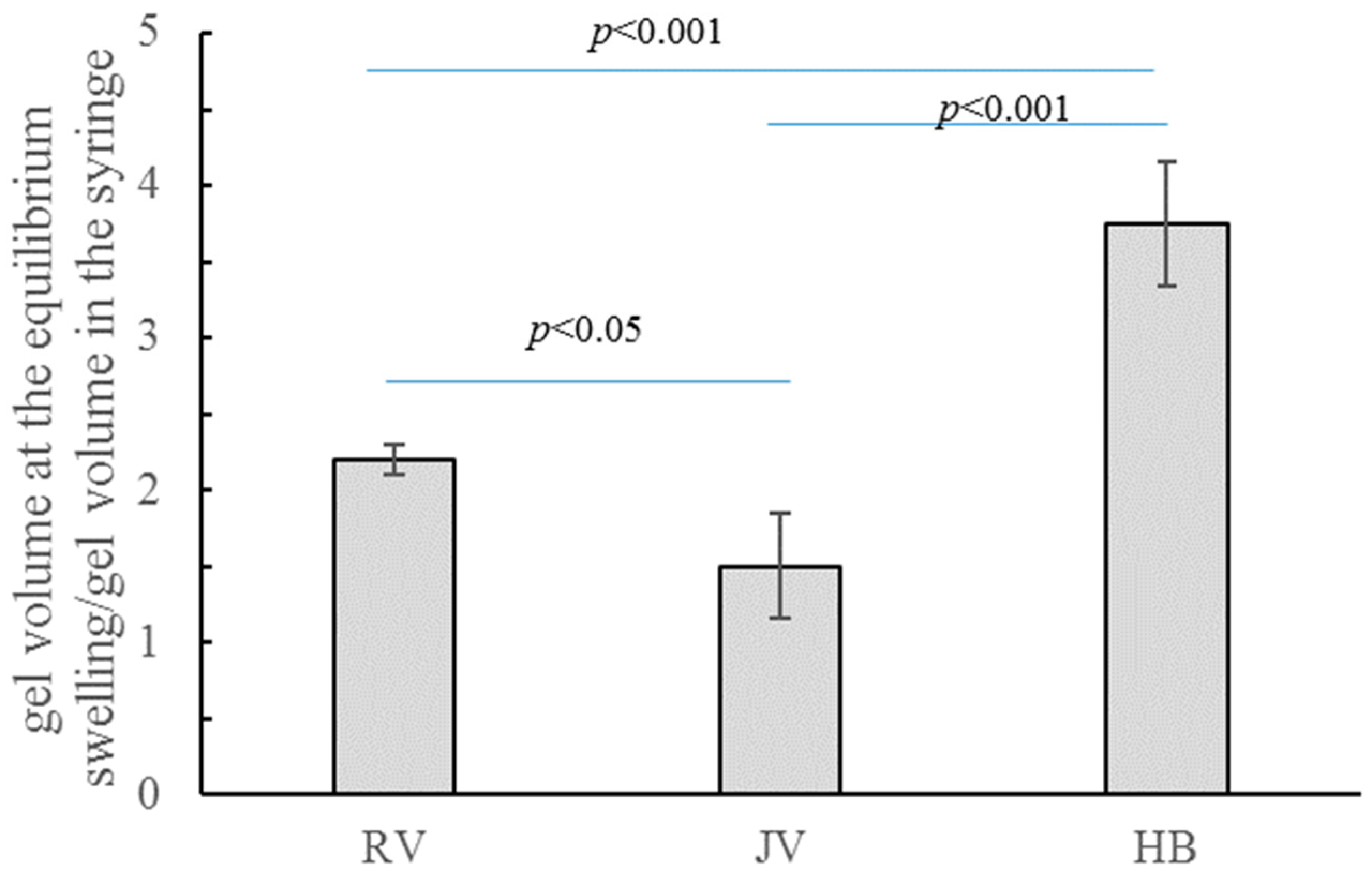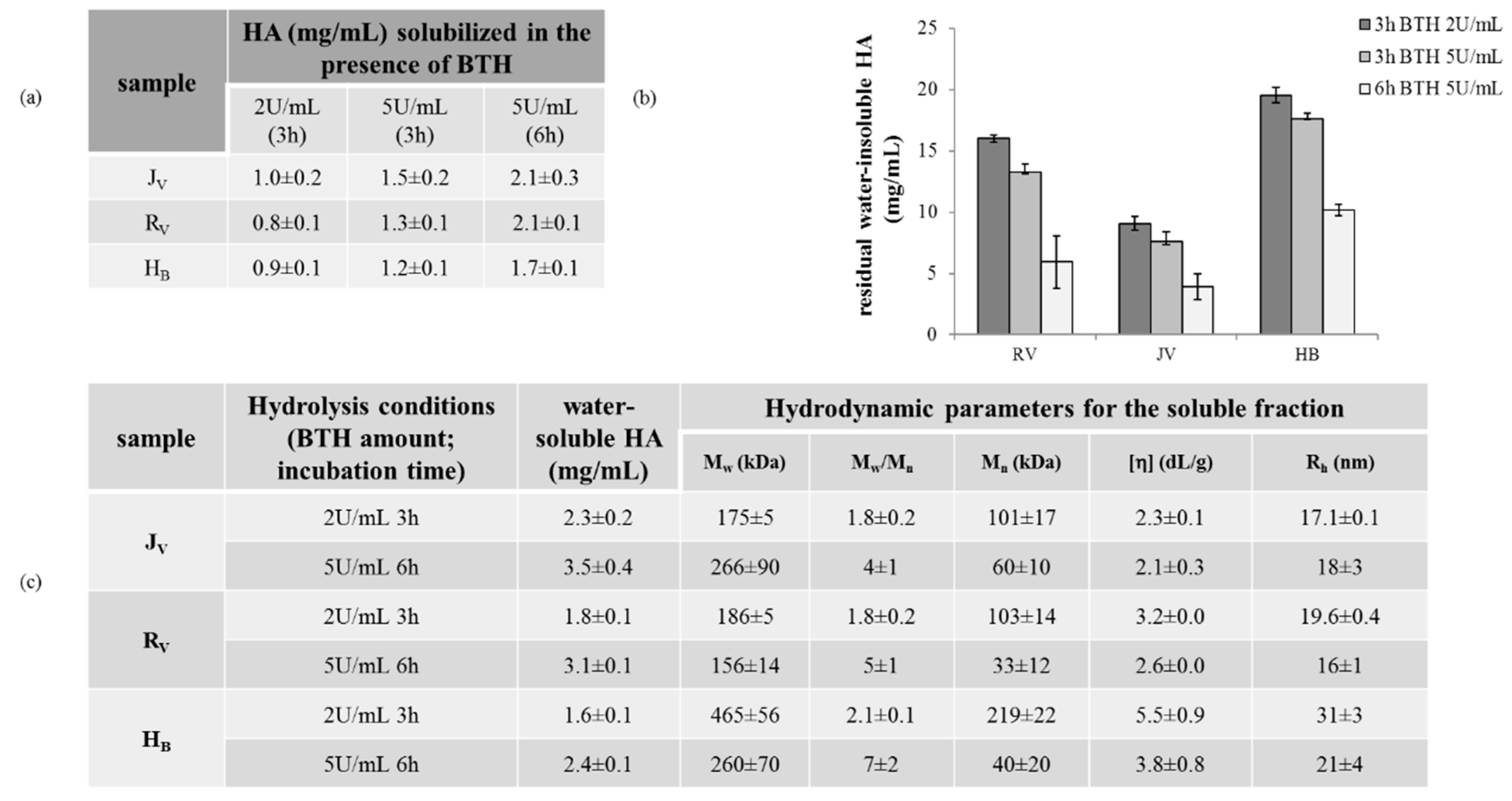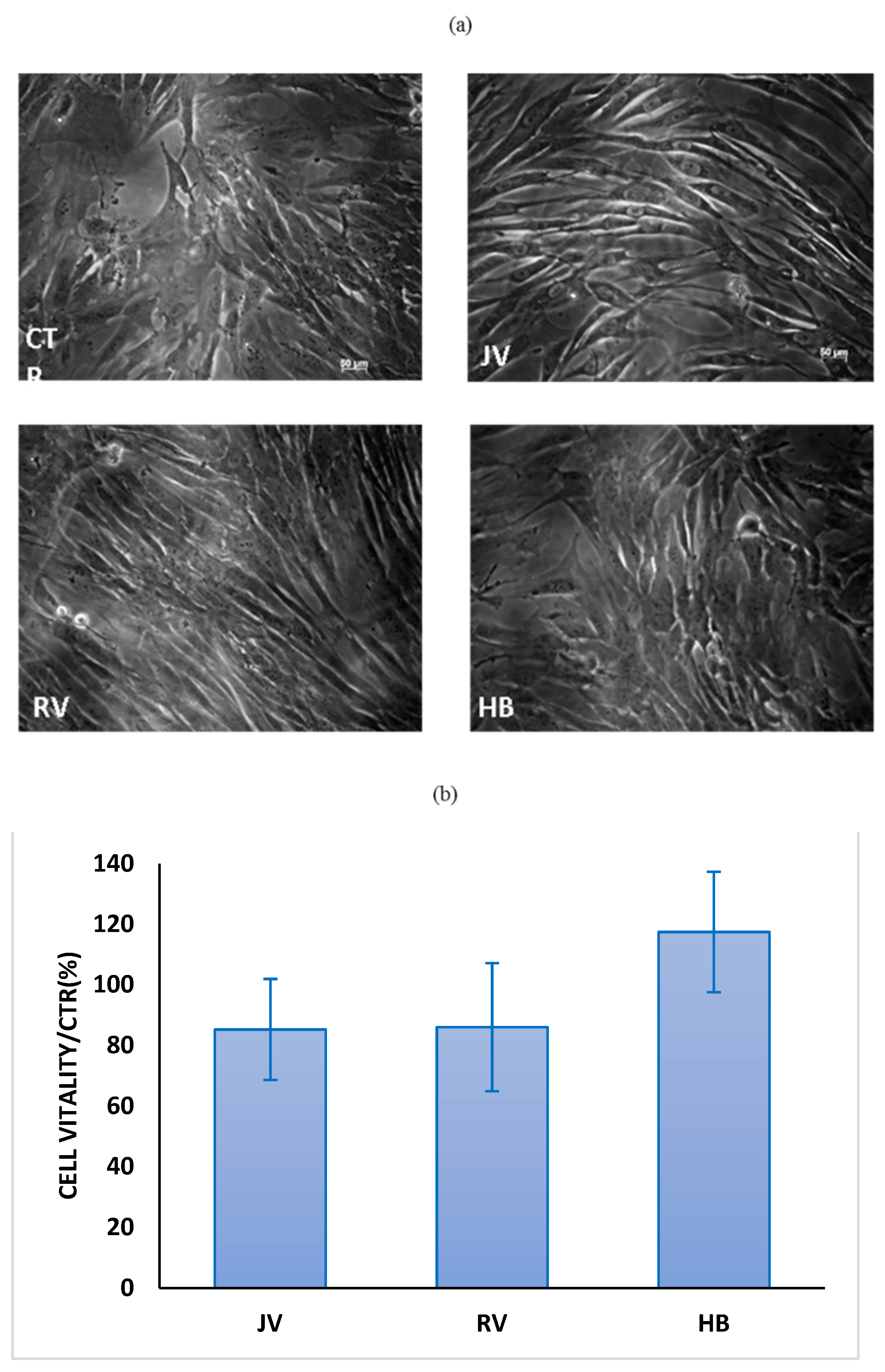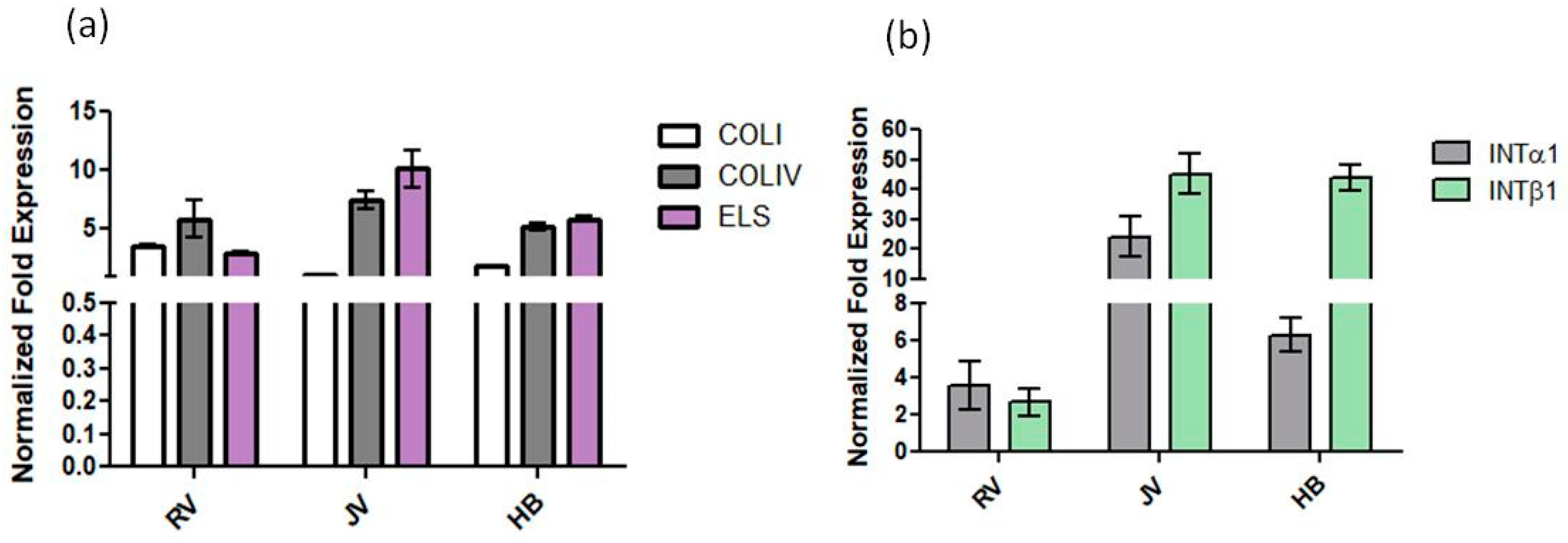Hyaluronan Hydrogels for Injection in Superficial Dermal Layers: An In Vitro Characterization to Compare Performance and Unravel the Scientific Basis of Their Indication
Abstract
1. Introduction
2. Results
2.1. Water-Soluble Fraction of Fillers: Quantitative Determination and Hydrodynamic Analysis
2.2. 1H-NMR Analyses
2.3. Hydration Capacity
2.4. Rheological Parameters
2.5. Degradation Studies
2.6. Cohesivity
2.7. Biological Studies
3. Discussion
4. Materials and Methods
4.1. Materials
4.2. Biophysical and Chemical Characterization
4.2.1. Soluble Fraction Quantification and Hydrodynamic Characterization
4.2.2. 1H-NMR Analyses
4.2.3. Hydration Capacity
4.2.4. Rheological Characterization
4.2.5. Stability to Degradation
4.2.6. Cohesivity
4.3. Biological Evaluation
4.3.1. Cell Cultures
4.3.2. Cell Viability (MTT Test)
4.3.3. Type I Collagen (COLIA1), Type IV Collagen (COLIVA1), Elastin (ELS) and Integrins (INTα1 and β1) mRNA Quantification Using qRT-PCR Analyses
4.3.4. Western Blotting for Collagen Type 1, Elastin, and Actin
4.4. Statistical Analysis
5. Conclusions
Supplementary Materials
Author Contributions
Funding
Acknowledgments
Conflicts of Interest
References
- Ave, M.N.; de Almeida Issa, M.C. Hyaluronic Acid Dermal Filler: Physical Properties and Its Indications. In Botulinum Toxins, Fillers and Related Substances. Clinical Approaches and Procedures in Cosmetic Dermatology; Issa, M., Tamura, B., Eds.; Springer: Cham, Switzerland, 2018; Volume 4, pp. 187–197. [Google Scholar]
- Fallacara, A.; Manfredini, S.; Durini, E.; Vertuani, S. Hyaluronic acid fillers in soft tissue regeneration. Facial. Plast. Surg. 2017, 33, 87–96. [Google Scholar] [CrossRef] [PubMed]
- Cui, Y.; Wang, F.; Voorhees, J.J.; Fisher, G.J. Rejuvenation of Aged Human Skin by Injection of Cross-linked Hyaluronic Acid. Plast. Reconstr. Surg. 2021, 147, 43S–49S. [Google Scholar] [CrossRef] [PubMed]
- Basta, S.L. Cosmetic fillers perspective on the industry. Facial. Plast. Surg. Clin. N. Am. 2015, 23, 417–421. [Google Scholar] [CrossRef]
- Heitmiller, K.; Ring, C.; Saedi, N. Rheologic properties of soft tissue fillers and implications for clinical use. J. Cosmet. Dermatol. 2021, 20, 28–34. [Google Scholar] [CrossRef]
- Moillard, S.G.; Betemps, J.B.; Hadjab, B.; Topchian, D.; Micheels, P.; Salomon, D. Key rheological properties of hyaluronic acid fillers: From tissue integration to product degradation. Plast. Aesthet. Res. 2018, 5, 17–24. [Google Scholar] [CrossRef]
- La Gatta, A.; Salzillo, R.; Catalano, C.; D’Agostino, A.; Pirozzi, A.V.A.; De Rosa, M.; Schiraldi, C. Hyaluronan-based hydrogels as dermal fillers: The biophysical properties that translate into a “volumetric” effect. PLoS ONE 2019, 14, e0218287. [Google Scholar]
- La Gatta, A.; De Rosa, M.; Frezza, M.A.; Catalano, C.; Meloni, M.; Schiraldi, C. Biophysical and biological characterization of a new line of hyaluronan-based dermal fillers: A scientific rationale to specific clinical indications. Mater. Sci. Eng. C Mater. Biol. Appl. 2016, 68, 565–572. [Google Scholar] [CrossRef]
- Allemann, I.B.; Baumann, L. Hyaluronic acid gel (Juvederm) preparations in the treatment of facial wrinkles and folds. J. Clin. Interv. Aging 2008, 3, 629–634. [Google Scholar]
- Muhn, C.; Rosen, N.; Solish, N.; Bertucci, V.; Lupin, M.; Dansereau, A.; Weksberg, F.; Remington, B.K.; Swift, A. The evolving role of hyaluronic acid fillers for facial volume restoration and contouring: A Canadian overview. Clin. Cosmet. Investig. Dermatol. 2012, 5, 147–158. [Google Scholar] [CrossRef]
- Borrell, M.; Leslie, D.B.; Tezel, A. Lift capabilities of hyaluronic acid fillers. J. Cosmet. Laser Ther. 2011, 13, 21–27. [Google Scholar] [CrossRef] [PubMed]
- Raspaldo, H. Volumizing effect of a new hyaluronic acid sub-dermal facial filler: A retrospective analysis based on 102 cases. Cosmet. Laser Ther. 2008, 10, 134–142. [Google Scholar] [CrossRef] [PubMed]
- Jones, D. Volumizing the Face with Soft Tissue Fillers. Clin. Plastic. Surg. 2011, 38, 379–390. [Google Scholar] [CrossRef] [PubMed]
- Sundaram, H.; Cassuto, D. Biophysical characteristics of hyaluronic acid soft-tissue fillers and their relevance to aesthetic applications. Plast. Reconstr. Surg. 2013, 132, 5S–21S. [Google Scholar] [CrossRef]
- La Gatta, A.; Schiraldi, C.; Papa, A.; De Rosa, M. Comparative analysis of commercial dermal fillers based on crosslinked hyaluronan: Physical characterization and in vitro enzymatic degradation. Polym. Degrad. Stab. 2011, 96, 630–636. [Google Scholar] [CrossRef]
- Falcone, S.J.; Berg, R.A. Crosslinked hyaluronic acid dermal fillers: A comparison of rheological properties. J. Biomed. Mater. Res. Part A 2008, 87, 264–271. [Google Scholar] [CrossRef]
- Edsman, K.; Nord, L.I.; Ohrlund, A.; Larkner, H.; Kenne, A.H. Gel properties of hyaluronic acid dermal fillers. Dermatol. Surg. 2012, 38, 1170–1179. [Google Scholar] [CrossRef]
- Edsman, K.L.M.; Ohrlund, A. Cohesion of hyaluronic acid fillers: Correlation between cohesion and other physicochemical properties. Dermatol. Surg. 2018, 44, 557–562. [Google Scholar] [CrossRef]
- Sundaram, H. Going with the flow: An overview of soft tissue filler rheology and its potential clinical applications (2of 3). Cosmet. Chall. 2011, 23–28. [Google Scholar]
- Sundaram, H.; Rohrich, R.J.; Liew, S.; Sattler, G.; Talarico, S.; Trévidic, P.; Molliard, S.G. Cohesivity of Hyaluronic Acid Fillers: Development and Clinical Implications of a Novel Assay, Pilot Validation with a Five-Point Grading Scale, and Evaluation of Six U.S. Food and Drug Administration-Approved Fillers. Plast. Reconstr Surg. 2015, 136, 678–686. [Google Scholar] [CrossRef]
- La Gatta, A.; Schiraldi, C.; Zaccaria, G.; Cassuto, D. Hyaluronan Dermal Fillers: Efforts Towards a Wider Biophysical Characterization and the Correlation of the Biophysical Parameters to the Clinical Outcome. Clin. Cosmet. Investig. Dermatol. 2020, 13, 87–97. [Google Scholar] [CrossRef]
- Sparavigna, A.; La Gatta, A.; Bellia, G.; La Penna, L.; Giori, A.M.; Vecchi, G.; Tenconi, B.; Schiraldi, C. Evaluation of the Volumizing Performance of a New Volumizer Filler in Volunteers with Age-Related Midfacial Volume Defects. Clin. Cosmet. Investig. Dermatol. 2020, 13, 683–690. [Google Scholar] [CrossRef] [PubMed]
- Kablik, J.; Monheit, G.D.; Yu, L.P.; Chang, G.; Gershkovich, J. Comparative physical properties of hyaluronic acid dermal fillers. Dermatol. Surg. 2009, 35, 302–312. [Google Scholar] [CrossRef]
- Stocks, D.; Sundaram, H.; Michaels, J.; Durrani, M.J.; Wortzman, M.S.; Nelson, D.B. Rheological evaluation of the physical properties of hyaluronic acid dermal fillers. J. Drugs Dermatol. 2011, 10, 974–980. [Google Scholar]
- La Gatta, A.; Salzillo, R.; Catalano, C.; Pirozzi, A.V.A.; D’Agostino, A.; Bedini, E.; Cammarota, M.; De Rosa, M.; Schiraldi, C. Hyaluronan-based hydrogels via ether-crosslinking: Is HA molecular weight an effective means to tune gel performance? Int. J. Biol. Macromol. 2020, 144, 94–101. [Google Scholar] [CrossRef] [PubMed]
- Sito, G. Hydrolift Action: A New Approach in Facial Reshaping. IBSA Hyaluronic Acid Experts. Available online: prime-journal.com (accessed on 25 March 2013).
- Arsiwala, S.Z. Current trends in facial rejuvenation with fillers. J. Cutan. Aesthet. Surg. 2015, 8, 125–126. [Google Scholar] [CrossRef]
- Kerscher, M.; Buntrock, H.; Hund, M.; Mokosch, A.; Ogilvie, A.; Samimi-Fard, S.; Waibel, M. Restylane® Skinboosters™ for the improvement of the skin quality—Results of a consensus meeting. Cosmet. Med. 2017, 17, 28–34. [Google Scholar]
- Niforos, F.; Ogilvie, P.; Cavallini, M.; Leys, C.; Chantrey, J.; Safa, M.; Abrams, S.; Hopfinger, R.; Marx, A. VYC-12 Injectable Gel Is Safe and Effective for Improvement of Facial Skin Topography: A Prospective Study. Clin. Cosmet. Investig. Dermatol. 2019, 12, 791–798. [Google Scholar] [CrossRef]
- Beatini, A.; Piersini, P.; Russo, R. “REAL LIFE” efficacy evaluation of a new hyaluronic acid gel suitable for deep hydration and fine wrinkles correction. Aesthetic Med. J. 2019, 5, 19–24. [Google Scholar]
- Viscoderm Hydrobooster® [Package Insert]; RosePharma S.A.: Lugano, Switzerland, 2019.
- Juvederm Volite® [Package Insert]; Allergan: Pringy, France, 2019.
- Restylane® SkinboostersTM Vital; Q-Med AB: Uppsala, Sweden, 2019.
- D’Agostino, A.; Stellavato, A.; Corsuto, L.; Diana, P.; Filosa, R.; La Gatta, A.; De Rosa, M.; Schiraldi, C. Is molecular size a discriminating factor in hyaluronan interaction with human cells? Carbohyd. Polym. 2017, 157, 21–30. [Google Scholar] [CrossRef] [PubMed]
- Urdiales-Gálvez, F.; Delgado, N.E.; Figueiredo, V.; Lajo-Plaza, J.V.; Mira, M.; Moreno, A.; Ortíz-Martí, F.; Del Rio-Reyes, R.; Romero-Álvarez, N.; Del Cueto, S.R.; et al. Treatment of Soft Tissue Filler Complications: Expert Consensus Recommendations. Aesthetic Plast. Surg. 2018, 42, 498–510. [Google Scholar] [CrossRef]
- Beasley, K.L.; Weiss, M.A.; Weiss, R.A. Hyaluronic acid fillers: A comprehensive review. Facial. Plast. Surg. 2009, 25, 86–94. [Google Scholar] [CrossRef]
- Sundaram, H.; Fagien, S. Cohesive Polydensified Matrix Hyaluronic Acid for Fine Lines. Plast. Reconstr. Surg. 2015, 136 (Suppl. 5), 149–163. [Google Scholar] [CrossRef]
- Stern, R.; Jedrzejas, M. Hyaluronidases: Their genomics, structures, and mechanism of action. Chem. Rev. 2006, 106, 818–838. [Google Scholar] [CrossRef] [PubMed]
- Sall, I.; Ferard, G. Comparison of the sensitivity of 11 crosslinked hyaluronic acid gels to bovine testis hyaluronidase. Polym. Degrad. Stabil. 2007, 92, 915–919. [Google Scholar] [CrossRef]
- La Gatta, A.; De Rosa, M.; Marzaioli, I.; Busico, T.; Schiraldi, C. A complete hyaluronan hydrodynamic characterization using a size exclusion chromatography-triple detector array system during in vitro enzymatic degradation. Anal Biochem. 2010, 404, 21–29. [Google Scholar] [CrossRef] [PubMed]
- Pérez-Sánchez, A.; Barrajón-Catalán, E.; Herranz-López, M.; Micol, V. Nutraceuticals for Skin Care: A Comprehensive Review of Human Clinical Studies. Nutrients 2018, 10, 403. [Google Scholar] [CrossRef] [PubMed]
- Shin, J.W.; Kwon, S.H.; Choi, J.Y.; Na, J.I.; Huh, C.H.; Choi, H.R.; Park, K.C. Molecular Mechanisms of Dermal Aging and Antiaging Approaches. Int. J. Mol. Sci. 2019, 20, 2126. [Google Scholar] [CrossRef] [PubMed]
- El-Domyati, M.; Attia, S.; Saleh, F.; Brown, D.; Birk, D.E.; Gasparro, F.; Ahmad, H.; Uitto, J. Intrinsic aging vs. photoaging: A comparative histopathological, immunohistochemical, and ultrastructural study of skin. Exp. Dermatol. 2002, 11, 398–405. [Google Scholar] [CrossRef] [PubMed]
- de Filippis, A.; D’Agostino, A.; Pirozzi, A.V.A.; Tufano, M.A.; Schiraldi, C.; Baroni, A. Q-switched Nd-YAG laser alone and in combination with innovative hyaluronic acid gels improve keratinocytes wound healing in vitro. Lasers Med. Sci. 2020. [Google Scholar] [CrossRef]
- Manou, D.; Caon, I.; Bouris, P.; Triantaphyllidou, I.E.; Giaroni, C.; Passi, A.; Karamanos, N.K.; Vigetti, D.; Theocharis, A.D. The Complex Interplay Between Extracellular Matrix and Cells in Tissues. Methods Mol. Biol. 2019, 1952, 1–20. [Google Scholar]
- Moulin, V.; Plamondon, M. Differential expression of collagen integrin receptor on fetal vs. adult skin fibroblasts: Implication in wound contraction during healing. Br. J. Dermatol. 2002, 147, 886–892. [Google Scholar] [CrossRef]
- Donejko, M.; Rysiak, E.; Galicka, E.; Terlikowski, R.; Głażewska, E.K.; Przylipiak, A. Protective influence of hyaluronic acid on focal adhesion kinase activity in human skin fibroblasts exposed to ethanol. Drug Des. Devel. Ther. 2017, 11, 669–676. [Google Scholar] [CrossRef] [PubMed]
- Stellavato, A.; Corsuto, L.; D’Agostino, A.; La Gatta, A.; Diana, P.; Bernini, P.; De Rosa, M.; Schiraldi, C. Hyaluronan Hybrid Cooperative Complexes as a Novel Frontier for Cellular Bioprocesses Re-Activation. PLoS ONE 2016, 11, e0163510. [Google Scholar] [CrossRef] [PubMed]








| HA (mg/mL) | RV | JV | HB |
|---|---|---|---|
| total | 20 | 12 | 25 |
| Water-soluble | 4.7 ± 0.6 | 4.0 ± 0.6 | 4.2 ± 0.9 |
| Water-insoluble | 15.4 ± 0.6 | 8.0 ± 0.6 | 20.8 ± 0.9 |
| Soluble HA (wt%) | 23 ± 3 | 33 ± 5 | 17 ± 4 |
| Sample | Hydrodynamc Parameters for the Soluble HA Fractions | ||||
|---|---|---|---|---|---|
| MW (kDa) | Mn (kDa) | MW/Mn | [η] (dL/g) | Rh (nm) | |
| RV | 266 ± 29 | 109 ± 19 | 2.5 ± 0.6 | 5.7 ± 0.1 | 26.8 ± 1.1 |
| JV | 161 ± 21 | 49 ± 5 | 3.3 ± 0.2 | 3.4 ± 0.2 | 17.9 ± 1.0 |
| HB | 525 ± 23 | 305 ± 55 | 1.7 ± 0.2 | 7.5 ± 0.4 | 37.2 ± 1.7 |
| Gene Name (Symbol) | PCR Primer Sequence 5′-3′ | Amplicon Length (bp) |
|---|---|---|
| Glyceraldehyde3-phosphate dehydrogenase (GAPDH) | TTCCACGGCACAGTCAA GCAGGTCAGGTCCACAA | 115 |
| Type I collagen (COLIA1) | CCAGAAGAACTGGTACATCA CCGCCATACTCGAACTGGAA | 103 |
| Type IV collagen (COLIVA1) | GGATCGGCTACTCTTTTGTGATG AAGCGTTTGCGTAGTAATTGCA | 104 |
| Elastin (ELS) | AGGTGTATACCCAGGTGGCGTGCT CAACCCCTGTCCCTGTTGGGTAAC | 105 |
| α-1 integrin (INTα1) | TCGCCAGCTTTGGAAGTCAT ATGTACTGGAGTTGGGCAGC | 108 |
| β-1integrin (INTβ1) | ACTGTGATGCCGTATATTAGCAC GATATGCGTTGCTGACCAACA | 110 |
Publisher’s Note: MDPI stays neutral with regard to jurisdictional claims in published maps and institutional affiliations. |
© 2021 by the authors. Licensee MDPI, Basel, Switzerland. This article is an open access article distributed under the terms and conditions of the Creative Commons Attribution (CC BY) license (https://creativecommons.org/licenses/by/4.0/).
Share and Cite
La Gatta, A.; Aschettino, M.; Stellavato, A.; D’Agostino, A.; Vassallo, V.; Bedini, E.; Bellia, G.; Schiraldi, C. Hyaluronan Hydrogels for Injection in Superficial Dermal Layers: An In Vitro Characterization to Compare Performance and Unravel the Scientific Basis of Their Indication. Int. J. Mol. Sci. 2021, 22, 6005. https://doi.org/10.3390/ijms22116005
La Gatta A, Aschettino M, Stellavato A, D’Agostino A, Vassallo V, Bedini E, Bellia G, Schiraldi C. Hyaluronan Hydrogels for Injection in Superficial Dermal Layers: An In Vitro Characterization to Compare Performance and Unravel the Scientific Basis of Their Indication. International Journal of Molecular Sciences. 2021; 22(11):6005. https://doi.org/10.3390/ijms22116005
Chicago/Turabian StyleLa Gatta, Annalisa, Maria Aschettino, Antonietta Stellavato, Antonella D’Agostino, Valentina Vassallo, Emiliano Bedini, Gilberto Bellia, and Chiara Schiraldi. 2021. "Hyaluronan Hydrogels for Injection in Superficial Dermal Layers: An In Vitro Characterization to Compare Performance and Unravel the Scientific Basis of Their Indication" International Journal of Molecular Sciences 22, no. 11: 6005. https://doi.org/10.3390/ijms22116005
APA StyleLa Gatta, A., Aschettino, M., Stellavato, A., D’Agostino, A., Vassallo, V., Bedini, E., Bellia, G., & Schiraldi, C. (2021). Hyaluronan Hydrogels for Injection in Superficial Dermal Layers: An In Vitro Characterization to Compare Performance and Unravel the Scientific Basis of Their Indication. International Journal of Molecular Sciences, 22(11), 6005. https://doi.org/10.3390/ijms22116005









